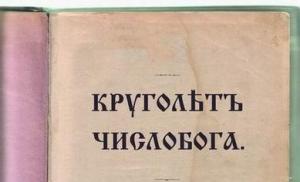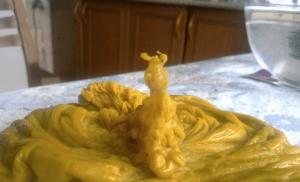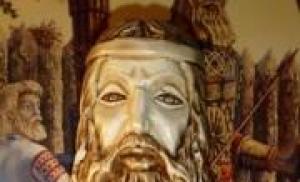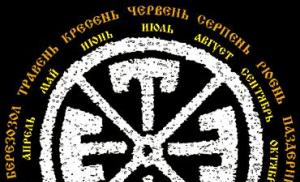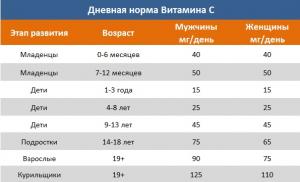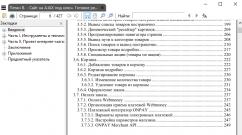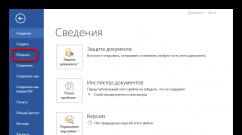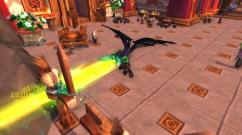Objects and phenomena of animate and inanimate nature in autumn, winter, spring and summer: description. Signs of autumn, winter, spring and summer in living and inanimate nature: description
Polina Andrienko
Summary of GCD for familiarization with the outside world “Winter. Winter signs»
Integration of educational areas: « Cognitive development»; « Speech development»; « Physical development"; "Social and communicative development"; "Artistic and aesthetic development".
Target: Strengthen the signs of winter in children, seasonal changes in nature, associated with the winter period.
Tasks:
Clarify and expand children's ideas about winter, about snow.
Encourage children to analyze, draw conclusions, correctly formulate their answer.
Develop logical thinking, ingenuity, imagination while guessing riddles.
Arouse positive aesthetic feelings and emotions in children while listening to a musical composition.
To promote active and benevolent interaction of children with a teacher and peers in solving game and cognitive tasks.
Continue to improve your pencil drawing skills. Develop imagination, the ability to convey a conceived pattern on paper.
Material:
Pictures with signs of winter; pictures: snowdrift, blizzard, frost, patterns on glass, snowflakes, fish under the ice; for did. games: pictures depicting a waterfall, river, puddle, ice, snowfall, clouds, rain, steam, snowflakes, drops, etc .; for drawing: colored paper (black or purple, white pencil, musical composition "Waltz of Snow Flakes" from the ballet "Nutcracker" by PI Tchaikovsky.
Directly educational activities:
1. Conversation about winter.
Children sit on high chairs.
Illustrations with winter landscapes hang on the chalkboard. The teacher reads a poem by I. Nikitin "The Meeting of Winter".
Hello, guest - winter!
We ask for your mercy,
Songs of the north to sing through the forests and steppes.
We have expanse - walk anywhere;
Build bridges over rivers and spread carpets.
We won't get used to it, -
Let your frost crack
Our Russian blood burns in the cold!
Educator: Are you guys happy about winter? What do you like to do most in winter?
Let's take a look at the illustrations and talk about the signs of winter. How is winter different from other seasons?
Children call the signs of winter:
The sky is gray, the sun shines a little. If it shines, it doesn't warm.
Everything around is covered with a white blanket - snow.
People put on warm clothes - it became cold outside.
The animals in the forest changed their light coats to warm, winter ones. Some of the animals hibernate.
Wintering birds are cold and hungry. They fly closer to a person's dwelling.
Educator:
How many months does winter last? Name the winter months.
Guys, do you know why winter is coming?
Because the Earth, our planet, at this time of the year is so inclined towards the Sun that it receives less sunlight, and therefore, it receives less heat and light. Therefore, the temperature is dropping, the days are getting shorter and the nights are longer.
Why does it snow in winter? Where does it come from?
In winter, when it is cold, the water droplets in the clouds freeze and turn into snowflakes. Therefore, it snows in winter and rain in the warm season.
Let's take a look at snowflakes. Are they the same? What is the difference?
All snowflakes are different: there are six-pointed stars, needle batteries, fluffs, lamellar hedgehogs, snowflakes cufflinks. The shape of the snowflakes varies greatly depending on the weather. On a windless frosty day, snowflakes fall slowly, they are large, shiny, like stars. They fall one by one, so it is easy to see them by catching a snowflake on a mitten. In a mild frost, snowflakes look like small balls, so they say that "snow pellets" are coming. And with a strong the wind is coming continuous "snow dust" - the wind broke off their beautiful rays at the snowflakes. V severe frost the snow crunches underfoot - it is the rays of snowflakes breaking from our weight, which from the frost have become fragile, brittle. When there is no frost, snow falls in flakes. These flakes are made up of many stuck together snowflakes.
What is the name of the wind with snow? (blizzard)
Blizzard is blizzard. Strong wind lifts up individual, rump-like snowflakes. Sometimes the snowstorm is so strong that you can't see anything around.
What is the name of the snow that forms on tree branches after a slight thaw? (frost)
In frost, ice crystals form on grass or trees. Sometimes the frost is so white that it can be mistaken for snow.
What are the painted windows called in winter? (winter patterns, frost)
In severe frost, beautiful patterns are often formed on the windows. These patterns are different: some look like fern leaves, they are called "Father Frost's Garden", others look like a forest fairy tale.
Physical minute "Walk"
One, two, three, four, five
We went for a walk in the yard.
They sculpted the Snow Baba,
The birds were fed with crumbs,
Then we rode at the rink,
And they were lying in the snow,
Everyone came home in the snow
We ate the soup and went to bed.
Educator: Well done guys, how much you know about winter. A
riddles
can you guess?
It is soft, not a pillow.
He is white, not fluff,
He's cold as a frog
And you will warm it with a trickle. (snow)
The star spun
A little bit in the air.
Sat down and melted
On my palm. (Snowflake)
Who, guess, is the gray-haired mistress:
The feather beds will shake - over the world of fluff. (winter)
Who paves the bridge on the river
No ax, no nails, no planks? (freezing)
And not snow, and not ice,
And he will remove the trees with silver in winter. (frost)
Didactic ball game "Find the right word"
What words can you say about winter, what is it like? - Snowy, blizzard, frosty, cold, harsh, soft, white, etc.
What kind of snow is there? (white, fluffy, cold, sparkling, sparkling, silvery, crispy, soft, etc.)
What is a snowflake? (light, airy, openwork, transparent, carved, beautiful, white, etc.)
Didactic exercise "Name kindred words"
(clap your hands):
Highlighting related words by the way, snow is from a number of words that are close in meaning: winter, snow, snowfall, cold, winter quarters, snowman, snowy, blizzard, Snow Maiden, frosts, Santa Claus, frost, freezer, snowflake, winter quarters, snowdrop, wintering, blizzard, wintering, bullfinch ...
Didactic game "Where are the snowflakes?"
Children are dancing around the cards laid out in a circle. The cards show various states waters: waterfall, river, puddle, ice, snowfall, cloud, rain, steam, snowflakes, drop, etc.
While moving in a circle, the following words are pronounced:
Summer has arrived.
The sun shone brighter.
It became hotter to bake,
Where should I look for a snowflake?
WITH the last word everyone stops. Those in front of whom the necessary pictures are located should raise them and explain their choice. The movement continues with the words:
Finally winter has come:
Cold, blizzard, cold.
Go out for a walk.
Where should we look for a snowflake?
The desired pictures are selected again and their choice is explained.
Educator: Well done, guys, did the job.
5. Artistic creation.
Educator: Today we talked a lot about winter, about snowflakes. Listen to the poem:
Downy snowflakes,
Merry, alive!
You spin, twinkle
In the silence of the forest.
And you cover the ground
Shiny silver!
Educator: I suggest that you draw snowflakes on colored paper with a white pencil.
Children, using the samples attached to the easel, do the work, depicting a snowflake all over the sheet of paper different ways(optionally).
The work is performed to a musical composition "Waltz of Snow Flakes" from the ballet "Nutcracker" by P. I. Tchaikovsky.
Children attach the finished drawings to the board.
6. Reflection.
Guys, what did we talk about today?
What new have you learned? What did you like the most?
This is the coldest time of the year.
The winter months are December, January and February.
December- from the Latin "decem", which means "ten", tk. December was the tenth month for the Romans.
Other names for December: jelly, cold, windy, ferocious, winter road.
In December, on December 21-22, there is the shortest daylight hours and the most long night- this time winter solstice.
December ends the year and winter begins.
December is cold for the whole winter the earth is cold.
January- from latin word"Januarius", in honor of the two-faced god of the sun and wind Janus, who guarded time, entrances and exits, was in charge of the beginning human life.
Other names for January: snowflake, snowman, fireball, prosinets, pinch, crackling, jelly, ice, ssechen (because average month winter cuts it in half and cuts off the past year from the coming).
January is the beginning of the year and the middle of winter.
January wears a sheepskin coat to his toes, paints cunning patterns on the windows, flatters his eye with snow and tears his ear with frost.
January is the sovereign of winter.
February- from the Latin "februaris", which means "cleansing". Cleansing before nature is reborn again.
Other names for February: bokogrey (because the February sun heats only the side turned to it, and the other freezes), blizzard (due to frequent frosts and snowstorms), low water (conditional boundary between winter and spring).
February is the shortest month of the year. February days- sunny, light, but cold and frosty. In February, the day is already noticeably increasing.
February is changeable: it will pull in January, then it will overlook in March.
February will add three o'clock in the afternoon.
What changes are taking place in inanimate nature in winter?
With the onset of winter, everything becomes colder, frosts come. Almost always in winter, the sky is covered with clouds, which no longer bring rain, but snow. It covers the ground, tree branches, rooftops. Frost freezes lakes, rivers, streams.
This is because the sun at this time of the year is low above the ground and does not warm the ground. The cold air brings clouds, in which the raindrops under the influence of the cold turn into snowflakes.
In calm weather, snowflakes fall to the ground calmly, but as soon as the wind blows, it rises snowstorm, leaving behind drifts and drifts.
In winter, there are severe frosts. In such weather, the snow becomes loose and squeaky.
Sometimes in winter, warm air currents reach snowy areas and slightly increase the air temperature. Coming thaw- warm sunny days during which the snow becomes soft, and you can make snowballs and snowmen from it.
White, patterned
Little star
Fly into my hand
Sit down a minute!
The star spun
A little bit in the air
Sat down and melted
On my palm.
The upper layer of water in reservoirs - rivers, lakes, ponds and streams - freezes and becomes covered with a thick layer of ice.
At the end of winter, when the sun warms up the roofs, the snow begins to melt, but the frost has time to turn the water into icicles.
During the thaw, when the glass of the windows is covered with a thin layer of water, frost forms fantastic patterns on them. This is a thin layer of ice, which consists of the smallest crystals, folded into bizarre shapes.
What are snow and ice like?
Sometimes tree branches, telephone wires, antennas on the roofs of houses are covered rime — fluffy snow.
Snow and ice are lighter than water, so in spring ice floes and snowdrifts float down the river until they melt and turn into water.
Fragile, transparent ice and loose, free-flowing snow under the influence of heat turns into water, and water under the influence of cold turns into ice and snow.
Plants in winter
At the end of winter, new changes take place in inanimate nature. The sun rises higher above the ground, shines brighter and is more often shown from behind the clouds. Although the frosts are still not abating, the snow is already beginning to melt on sunny days.
During the night, the thawed snow freezes again, and by morning it appears crust- dense ice crust.
Snow covers the ground with a thick carpet, under which, despite the cold, life continues.
It turns out that it is the snow blanket that keeps the plants alive. If you measure the air temperature above the snow and under the snow, on the ground, then it will be very different.
Above the snow, the thermometer shows 40 ° frost, and on the ground - only 10 ° frost. Even if the snow is thin, only 10 centimeters, the temperature on the soil will be 15–20 ° higher than above the snow.
That is why such herbaceous plants like strawberries covered with snow do not die and even continue to grow. Wheat, strawberries, cranberries, rye winter under the snow.
The snow blanket warms not only plants, but also animals that get their food by making tunnels in the snow. Basically, these are mice. They feed on the seeds of plants covered with snow. The dens of bears, the burrows of badgers and hedgehogs are also covered with snow, which keeps them warm.
Most plants are prepared in advance for winter. In the fall, some herbaceous plants wither and leave their seeds on the soil. New herbs will grow from them in the spring.
Plants that reproduce by tubers, bulbs and rhizomes remain in the soil under a blanket of snow. Some of them, for example, goose onions, corydalis, woody anemone, continue to grow and turn green even under the snow, and bloom with the arrival of warmth.
Conifers overwinter with green leaves. Cones remain on them all winter. Fruits also remain on other plants - maple, acacia, mountain ash, wild rose, elderberry.
Trees and shrubs, shackled by the cold, flow into winter sleep... But despite the fact that almost all the trees have dropped their leaves for the winter, buds remain on their branches.
Already at the end of January, the buds on the willow grow. Inside the bud are small green leaves. Outside, the buds are covered with dark scales. When the buds enlarge, they shed their scales and become covered with a light fluff.
That is why the willows stand as if covered with silver by the end of winter.
Buds grow on other trees as well. Winter does not stop plant growth, it only delays it.
Birds in the winter.
Cold and lack of food force migratory birds to fly to warmer regions, but wintering types find food for themselves. They feed on insects hidden in dry leaves, under the bark of trees, in the cracks of houses and fences. In addition, buds, fruits and seeds were left on the branches of trees and shrubs.
Some birds, such as titmice and nuthatches, use the stocks they made in the fall in winter.
The crossbills feed on spruce and pine seeds. These trees have seeds that ripen in winter, which is why chicks appear at the crossbills at this time of the year. They have enough food to feed themselves and their offspring. Crossbill chicks are not cold in winter, because they are always full.
During blizzards and snowfalls, as well as in severe frost, when the trees are covered with frost, it is difficult for birds to get insects out from under the bark. After several hours of fasting, some birds may die.
Therefore, it is very important to feed the birds in winter. Arrange feeders in gardens, parks and squares.
Birds fly to the feeders and peck up not only the seeds, grains and bread crumbs left by you, but also insect pests on the trees and shrubs located next to the feeder. So birds are of great benefit.
If the birds constantly find food in the feeders, then they will fly to them in the summer, which means they will clear the trees of pests all year round.
By the silver path
As soon as New Go comes,
On a high thin leg
The miracle tree gets up.
This tree is not simple
And it's not for the guys.
Flying near the Christmas tree
Birds whistle merrily.
There is a woodpecker and tits,
Bullfinches, and a sparrow -
Everybody wants to have fun
Near your Christmas tree!
Toys do not shine on it
And the star does not shine
But on the other hand there are feeders for birds
We hung there!
Bird flocks arrive
To our Christmas tree in the winter garden,
And in the garden without stopping
The bells are ringing.
Z. Alexandrova
Beasts in winter
Fluffy fur and warm wool save animals from the winter cold.
The main concern for animals in winter time is the food. Even a badger that has accumulated enough fat in the fall and lies in hibernation, sometimes wakes up to eat something from his reserves.
Only the bear does not wake up - he has enough fat for the whole winter. The bear sleeps very lightly. We can say that he is not sleeping, but dozing, listening to everything that is happening around.
By the end of winter, the bear has little blind cubs. The she-bear feeds them with her milk. Only a month later, in the spring, when the sun warms up, the cubs begin to see clearly and leave the den to play and learn to get their own food.
Not only winter frost, but the animals are not afraid of hunger either. They long ago adapted to live in winter conditions and they know that food must be stored in the fall.
Foxes, hares, moose, wolves can find food for themselves in winter. The main winter food for foxes is mice. Thanks to its sharp eyesight, hearing and scent, the fox finds up to 20 mice per day.
Deer, moose and hares feed on the bark of trees and bushes in winter.
It is not as nutritious as grass, so people feed it with hay, aspen, willow and salt.
The chipmunk harvests up to 10 kilograms of nuts and grain for the winter. He brings them in cheek pouches and hides them in his pantries.
The squirrel sometimes hides its reserves so that later it cannot find them. Then she has to feed on the seeds of spruce and pine. She especially likes the seeds from the cones she ate: they have more fat than pine, and they are much more nutritious.
On warm autumn days, a small animal, the vole, brings various grains and seeds to its mink and puts them in separate minks.
But some beasts don't make any supplies. The river otter doesn't need them. In icy water, she is not cold and there is always enough food. It feeds on fish, frogs, crayfish and water rats. Fish in winter easily find food, but they can die from lack of air: air does not pass through the ice. It becomes difficult for fish to breathe, so in winter people break ice holes in the ice. So that the water does not freeze again, they put straw in the hole and sprinkle it with snow.
Pets in winter
Pets do not look for food for themselves, people care about it. Since the summer, farmers have been preparing stocks of silage, hay, straw, and grain.
In winter, cows, goats, sheep, pigs are kept in warm rooms, in which the cleanliness and health of animals are monitored.
At this time, cows give birth to calves, sheep give birth to lambs, and pigs give birth to pigs. Cubs feed on mother's milk until they are transferred to prepared food.
Winter in the city
Winter in the city is different from winter in the forest or in the field. Warm buildings, buildings, an abundance of transport, a large number of people and night lighting increase the temperature in the city. Therefore, in addition to the sparrows, crows and magpies familiar to the city, now you can meet the starlings, jackdaws, blackbirds, woodpeckers, and goldfinches remaining for the winter.
Berries on trees and shrubs serve as excellent food for them, and attics become good shelters for the whole winter. In addition, birds find their own food in city dumps.
In winter, small rodents begin to move closer to human habitation. In basements and tunnels, they are warm and there is always food. And their enemies - ferrets, weasels, ermines - move behind the mice.
Industrial enterprises dump waste into rivers and ponds warm waters, therefore, the water in such rivers does not freeze.
Labor of people in winter
In winter, people take care of pets. Several times a day, feed is distributed, water is supplied, and manure is removed. By receiving good food, cows and in winter give milk, and rabbits, sheep and pigs a sufficient amount of meat.
On the fields covered with snow, work does not stop - preparations are underway for spring sowing. Manure, fertilizers are transported to the fields, and work is carried out to retain snow: shields are installed, deep furrows are plowed - in spring, the water necessary for the soil accumulates in these places. The more moisture there is in the fields, the richer the harvest will be.
In rural workshops, seeders, tractors, cultivators, harrows, plows are being prepared for spring work. They need to be checked and repaired.
In gardens, plants are covered with snow to protect them from frost. About fruit trees it is necessary to compact the snow so that mice do not make their way to them.
In winter, sea buckthorn berries, rich in vitamins, are harvested. Frozen berries fall off the branches after lightly tapping on the trunk.
In granaries, ensure that they have a constant temperature. This is especially important for the seeds of grain crops. In vegetable stores, vegetables are regularly sorted out, removing rotten ones.
In the city, so that snow does not interfere with traffic, special vehicles clean roads, tramways and railways. After the thaw, the roads are covered with a layer of ice, so they are sprinkled with sand.
Winter is in a hurry, bustling,
Wrapped in snow
All the bumps and stumps
Benches and stacks.
Mittens turn white
On the branches of birches,
So that they do not catch a cold,
To withstand the frost.
Winter told the oak
Throw on fluffy fur
I put a fur coat on the spruce,
The warmth covered everyone.
Long lasting and reliable
In the river, she held ice together.
You can walk along the river -
Come to us, New Year!
O. Vysotskaya.
Help others! Press
We have collected for you interesting materials about winter, which both schoolchildren may need when writing stories and reports about this time of year, and teachers primary grades to familiarize students with the topic "Winter. Winter months. Winter phenomena nature. Winter signs of the weather. ", In this case, the story can be presented as a presentation. It will turn out to be a wonderful lesson or extra-curricular activity.
What is winter?
When the last multi-colored leaves finish crumbling and envelop the earth with their variegated carpet, and gray raindrops give way to chilly cold and the first sparkling snowflakes, winter comes into its own. She reigns for three whole months: a timid frosty December, snowy and festive January and, of course, February, famous for its harsh cold weather. In winter, nature sleeps sweetly, wrapped in a blanket of snow and soothed by the discordant, but melodic melodic tune of the blizzard. However, this exciting time of the year declares itself not only with a lush cap of snow-white snowdrifts and transparent icicles hanging from the roofs of houses, but also with a temperature that does not rise above zero degrees Celsius, and makes you wrap yourself up in warm clothes chilly.
Changes in nature in winter
December

December, which marks the arrival of winter, unlike the mild autumn November, very rarely spoils nature with its thaws. He carefully and gradually prepares for the onset of cold and frost, lowering the temperature column on the thermometer and wrapping everything around with a warm snow blanket. Thanks to this care, many small animals and plants can survive the coming cold weather, because it is warmer under the snow than outside. Sparkling snowdrifts often reach 30 cm and no longer surrender to the mercy of timid sunlight. The lower the air temperature, the harder the snow and the louder its melodic crunch becomes.
Gradually, the day begins to lose ground, and the cold December nights are getting longer. Short frosts are already beginning to show their harsh character and a thin crust of ice fetters the movement of winding rivers. Sometimes December pampers with small thaws and a pleasant rise in temperature, but it can remind of itself with sharp frosts, and the arctic winds gradually bring more and more cold and freshness.
In the northern hemisphere, the night of December 22 is the longest of the year, and the day of December 22 is the shortest of the year. On the winter solstice, December 22, the sun rises to its lowest height above the horizon for the entire year.
With the onset of December, a lot of folk signs about the weather are connected. Here is some of them:
- If in December the sky is cloudy and the clouds are hanging low, then it is worth waiting in next year big harvest.
- If thunder often thunders this month, then in January there will be very severe frosts.
- The absence of rain means that spring and summer will also be dry.
- Lots of snow, frost and frozen ground signify good harvest in the fall.
- If bullfinches arrived this month, then winter will be frosty.
In Russia, at the beginning of December, they already began to break through toboggan tracks and arranged triplets. From December 9, in the evening, it was worth staying closer to the houses, as the wolves began to approach closer to the village.

However, December marks not only the beginning of winter, but also an impatient anticipation of the New Year. This holiday, celebrated on the night of December 31 to January 1, is one of the most wonderful days, because it symbolizes not only the beginning of the new year, but also the time of finding new hopes and aspirations, faith in positive changes and magical events. Each person becomes a child on this holiday and looks forward to the onset of a bewitching fairy tale and the realization of all dreams. The scent of pine needles and the unique taste of tangerines awaken warm memories and make the heart beat faster in anticipation of miracles.
January

In January, winter comes into its own right. She serenely reigns in nature and continues her snowy and frosty procession. Epiphany cold and unique snow crystals create a magical winter's tale from intricate patterns on the windows, sing about her, spinning in the whirlpool of a blizzard, and boldly look into the cloudless blue sky. A bitter frost makes itself felt with puffs of steam from the mouth and a pleasant tingling of the cheeks and nose. All this magic maintains the temperature already established within -10-30 degrees Celsius. The days are gradually getting longer, and the impenetrable darkness of frosty nights is gradually losing ground. However, the piercing light bright sun does not have time to warm the earth, so the stubborn cold claims its rights even more strongly and makes the air piercingly frosty. Thanks to this, at night you can admire the clear sky and sparkling diamonds of the stars. The wind is not as strong as in December and does not flutter the trees dressed in snow, but only lovingly strokes their tops.
January is famous not only for its mesmerizing beauty, but also for the onset of important event in the life of Christians - the Nativity of Christ. This bright holiday, celebrated on January 7, is solemnly celebrated by all believers, and their congratulations to each other merge together to the ringing of bells.
The days from 7 to 19 January are called Christmastide. They are illuminated with the light of the Nativity of Christ and are great for different games, fortune-telling and carols. Most often, fortune-telling was performed on the night of January 13-14. Young girls wanted to know who would be their betrothed, and married women tried to find out what the weather will be like in summer and whether it is worth waiting for a big harvest. Christmastide was also a period of noisy weddings. In Russia, these days, sleigh rides and all kinds of snow fun were organized.

According to folk signs about the weather:
- if it blows on January 21 South wind, then the summer will be rainy, and if there is frost on the 23rd, the summer will be cool and rainy.
February

With the onset of February, the thick gray sky, which continues to wrap the sleeping ground with a soft cap of snow, gradually becomes a little kinder and allows bright sunlight to often peep through the dense clouds. Winter still reminds of itself with a discordant melody of a blizzard and a merry carousel of snowflakes swirled by a blizzard, but the anticipation of spring is gradually beginning to revive everything around. Cheeks pink from prickly frost gradually begin to warm up timid the warmth of the sun... The snow is covered with a thin crust and begins to give up on the sly, anticipating the approach of spring. The days are getting longer and clear sky more and more often pleases the eye with its unique blue.
In the southern regions of Russia, buds appear on willows - the first harbingers of spring, and thawed patches, like messengers, carry the news of its approach. Frosty wind pricks my face nicely small snowflakes and chilly frost alternates with long-awaited thaws. However, mesmerizing blizzards and stubborn cold weather will not soon surrender to the grace of the beautiful spring.
There are a lot of folk signs about the weather associated with February.
- If the weather is very cold and frosty this month, then the summer will be hot.
- Little snow in February threatens a bad harvest.
- If thunder is thundering, then it is worth waiting for strong winds.
- A rainy February speaks of the same spring and summer.
- Bright stars predict frost, and dim ones predict a thaw.
- If the frosts in February are very strong, then the winter will be short.
Signs of winter coming
One of the first signs of winter is the appearance of dense, low overhanging clouds... They, like a fur blanket, envelop the sky and do not allow the sun's rays to break through their veil and delight the earth with their warmth, and the sun is low and already warms up not so much. Such clouds are very different from summer, light and cirrus. The winter sky does not please with its colors, but it compensates for this in abundance with sparkling snowflakes, neatly, like sparkling silver, covering everything around.
Thick blanket of snow is also an important sign of winter. Only at this time of the year, fluffy snowflakes do not melt under the timid rays of the sun, but, gradually increasing, create a reliable snow cover.
Winter is also famous for its frosts. Gradually it gets colder. The thin needles of the first frosty winds begin to tingle on the cheeks and nose and make them wrap themselves more tightly in winter clothes... TO warm jacket her permanent companions are added - a hat and mittens.
Plants and animals are also actively preparing for the onset of winter. Trees and shrubs in anticipation of cold weather and cloudy days shed their leaves... However, this will not last long and in the spring the first small leaves will appear on the branches. Only coniferous trees do not want to part with their green needles and continue to delight them even in winter.
There is little food to eat in winter, so some animals hibernate and those that remain awake grow fluffy and thick fur. The hare, for example, turns white, while the hedgehog and the bear hibernate.
Birds also find it difficult to endure the cold and lack of abundant food, so many of them fly away to warm lands, and the rest adapt to different types stern.
Natural phenomena in winter
At this time of the year there are such interesting and unusual phenomena nature as:
- Blizzard
- Ice
- Icicles
- Frost patterns
A blizzard occurs with the first gusts of wind and, boldly picking up the snow cover, carries him into a mysterious winter dance. This is very harsh a natural phenomenon who better not get in the way. Blizzard boldly disposes of the snowy landscape and disposes of fluffy snowdrifts at will. Most often this happens in the middle of winter, when frost and cold reign supreme.

Ice, like a sweet winter dream, fetters water bodies and covers with a thin crust of ice not only the continuous flow of rivers, but all roads. This happens if, after rain or sleet, the temperature column drops below zero. Ice on rivers impedes navigation, but provides ample room for all kinds of winter fun such as: sledding, ice skating or skiing.

Another interesting phenomenon winters are icicles. They, like ice daggers, falling into the ground and scattering into hundreds of sparkling fragments. Icicles form when snow begins to melt on rooftops or other flat objects, and the resulting water freezes at night in low temperatures.

Frosty patterns, like hoarfrost, are an incredible lace creation for winter. Their whimsical design and mesmerizing beauty leave a lot of room for imagination and plunge into a snowy fairy tale. This becomes possible due to the formation of ice crystals that settle on the irregularities of the glass. They overlap and create pictures of incredible beauty.

Winter is not only beautiful time years, but also very unusual. She's like a big riddle to be solved. For example:
- snow is a real work of art and no two snowflakes are alike in the world.
- Snowflakes are 95% air, which is why they sink so slowly to the ground.
- In Antarctica, you can find purple, pink or red snow.
- V different countries and parts of the world ice has different temperatures... For example, the coldest ice is found in Antarctic glaciers and reaches -60 degrees Celsius, and the warmest (0 degrees) - on the peaks of the Scandinavian mountains and the Alps.
- More than half of the inhabitants of the Earth have never seen real snow at all.
- On February 18, 1979, snow was recorded in the Sahara Desert, and this is one of the hottest places on the planet.
- Enjoy the most warm winter possible in North Sudan. There, at this time of the year, the temperature rarely drops below +40 degrees.
- One of the coldest and most uninhabitable places is Antarctica. In winter, the average air temperature there is -70 degrees. And at Vostok station, which is located in Antarctica, a temperature of -89.2 degrees was recorded.
Winter is a wonderful and fabulous time of the year, when, despite the short day and frosty air, life does not freeze, but is filled with new light and sound. A snow-white blanket of snow and snowflakes sparkling in the sun, unique patterns on glass and an ice crust that fetters rivers and lakes are endlessly pleasing to the eye. The prickly frost, lovingly fluttering the cheeks, reminds of how many games there are fresh air conceals this time of year and makes you freeze in anticipation of the New Year holidays.

Synopsis on the immediate educational area on the formation of a holistic picture of the world
v senior group on lexical topic"Winter. Signs of winter "
Educator
the first
qualification
Kireeva
Helena
Victorovna
2014
Topic: “Winter. Signs of winter
Purpose: To clarify and expand children's ideas about winter, snow, about characteristic features winter.
Tasks:
Expand the horizons of children, consolidate knowledge about the state of living and inanimate nature.
Develop logical thinking, ingenuity, attention.
To form the foundations of safety for nature and one's own life.
Stroke
1. Organizational moment.
Guys, listen to the riddle.
Colds set in.
The water turned into ice.
Long-eared bunny gray
He turned into a white hare.
The bear stopped roaring:
A bear fell into hibernation.
Who will say, who knows
When does this happen? (In winter)
Well done! You guessed correctly.
2. The main part.
Listen to some more riddles:
1. It is soft, not a pillow.
He is white, not fluff,
He's cold as a frog
And you will warm - a trickle. (Snow)
2. Spun an asterisk
A little bit in the air.
Sat down and melted
On my palm. (Snowflake)
3 who paves the bridge on the river
No ax, no nails, no planks? (Freezing)
4. Neither snow nor ice,
And he will remove the trees with silver in winter (Hoarfrost)
Physical education "I'm not afraid of frost"
I'm not afraid of frostI will make friends with him!
The frost will come to me.
Touch your hand, touch your nose
So, we must not yawn:
Run, jump and jump.
Threaten with a finger
The palms are held together
Walking in place
Show
Jumping in place
Guys, what signs of winter do you know?
Children: the sky is gray, the sun shines a little. If it shines, it doesn't warm.
Everything around is covered with a white blanket - snow. People put on warm clothes - it's cold outside. The animals changed their coats. We went into hibernation (hedgehog, bear). Wintering birds are cold and hungry. They fly closer to a person's dwelling.
Tell me, what is the name of the heaps of snow on the ground?
Children: drifts.
What is the name of the wind with snow?
Children: blizzard.
A blizzard is a blizzard. A strong wind lifts up individual snowflakes, similar to rump. Sometimes the blizzard is so strong that you can't see anything around.
Frost happens when the air temperature drops below freezing point. It forms on tree branches after a slight thaw.
Guys, what's going on with the rivers?
Children: they are covered with ice.
What is the name of the phenomenon when snow falls in winter?
Children: snowfall.
What kind of snow is there?
Children: White, fluffy, cold.
What is snow made of?
Children: snow is made up of snowflakes.
Finger gymnastics "Pie"
Snow fell on the doorstepThe cat made himself a pie
In the meantime, he sculpted and baked,
Pie dripping like a brook
Pies for yourself
Not from snow - from flour.
2 times the palms are lowered onto the table.
Palm to palm, show how the cake is sculpted.
“They run with the fingers of both hands on the table.
Shows how the cake is baked.
The game “What? Which?"
What winter? (cold, frosty, snowy, etc.).
What snow? (white, fluffy, lightweight, etc.).
What ice? (cold, transparent, hard).
What frost? (winter, strong, harsh).
The game "Say it kindly"
Sleds - sleds.
Icicle is an icicle.
The slide is a slide.
An ice floe is an ice floe.
Winter is a winter.
Snow is snowball.
A snowflake is a snowflake.
Let's count a snowflake (1 snowflake, 2 snowflakes, 3 snowflakes, 4 snowflakes, 5 snowflakes), icicle, snowdrift, snowman).
Game "Finish the sentence"
Drafting complex sentences with the meaning of opposition.
In winter there is snowfall, and in autumn ... .. (leaf fall).
In winter, snow falls, and in spring .... (melts).
In winter they go sledding, and in summer .... (on a bicycle).
It can be cold in winter, and in summer ... (warm).
In winter, the trees are white, and in autumn ... (yellow).
Snowdrifts grow in winter, and in summer they grow ... (trees).
Well done! Today you played well, answered questions, and a big hello to you from winter! And sends you snowman coloring pages.
I distribute coloring pages to children.
3.Bottom line.
Tell me, what have you learned about spring?
What happens in spring?
What did you like?
Speech development Topic: "Winter" Purpose: To form children's ideas about the signs of winter; teach children to clearly answer questions, maintain a dialogue, retell the main meaning of the poem in their own words and read it with expression. To develop the ability to select the necessary adjectives in meaning. Bring up respect to nature. Date:
What day of the week is it today? What month is it? What's the weather outside? Listen carefully to the riddle: What time of year are we talking about? Look out the window, what time of year is it? Winter came after what time of year? Snow in the fields, Ice on the rivers, The fan walks, When does this happen? (In winter)

Winter has come - winter. The ground, trees, bushes were covered with white fluffy snow. The water in rivers and lakes froze and turned into ice. Cold winds often blow, blizzards sweep. The sun rarely shines, the sky is gray and cloudy. Birds keep closer to people's homes. People put on warm clothes: winter hats and fur coats or coats.

Examining a picture of winter: What is the sky? (Gray, gloomy). Is the sun bright or dim? Does the sun warm in winter? If there are leaves on the trees? When did they fall? If green grass on the ground? What do we see on the ground and in the trees? What snow in winter? (White, fluffy, cold). Are the days in winter long or short? What happened to the rivers?


Now read the poem carefully to the child: It snows quietly, White snow, shaggy. We will clear the snow and years In the yard with a shovel. From the gate, we can hardly lead the path to us. Mom will come out on the threshold, Say: “Who could this lead the path To our threshold? (M. Poznanskaya) What does the poem say? How is the author described snow? What were the children doing in the yard? What did mom say? The teacher reads the poem again, then gradually learns it with the child.

Physical education And now let's rest. Is it cold in winter? What happens to a person if he is in the cold for a long time? We are frozen with you (clap our hands) And chatter our teeth, (pat ourselves on the shoulders) Clap our hands, (pat our knees) Stamp their feet. (stamp their feet)

Snow (what is it doing?) ... (walking, flying, lying down, sweeping, spinning) The sun (what is it doing?) ... (shining, but not warming, hiding behind the clouds) Water (what is it doing?) ... (freezes, says goodbye to the ice) The wind (what is it doing?) ... (blowing, howling) Frost (what is it doing?) ... (freezing, biting, stinging). Exercise "Find Action Words"

Exercise "What, what, what?" Snow (what?) ... (wet, loose, deep, fluffy) Ice (what?) ... (cold, slippery, transparent, thick, thin) Sky (what?) ... (gray, egg, cloudless) Sun (what?) ... (cold, dull, bright) Snowflakes (what?) ... (gentle, light, beautiful).


Exercise "Nothing?" Calls words in plural and asks to answer the question: "No what?", using the named word: Frost - no ... (frost), winds - no ... (winds), blizzards - no ... (blizzards), snow - no ... (snow), snowflakes - no ... (snowflakes), ice - no ... (ice), drifts - no ... (drifts), clouds - no ... (clouds)



